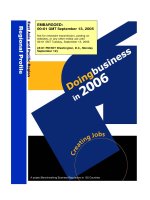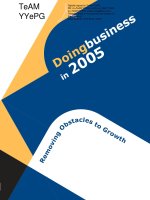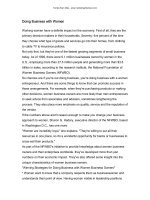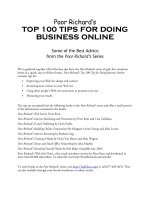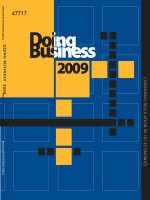doing business 2010 peru
Bạn đang xem bản rút gọn của tài liệu. Xem và tải ngay bản đầy đủ của tài liệu tại đây (775.48 KB, 80 trang )
Doing Business 2010
Peru
© 2009 The International Bank for Reconstruction and Development / The World Bank
1818 H Street NW
Washington, D.C. 20433
Telephone 202-473-1000
Internet www.worldbank.org
E-mail
All rights reserved.
1 2 3 4 08 07 06 05
A copublication of The World Bank and the International Finance Corporation.
This volume is a product of the staff of the World Bank Group. The findings, interpretations, and conclusions
expressed in this volume do not necessarily reflect the views of the Executive Directors of the World Bank or the
governments they represent. The World Bank does not guarantee the accuracy of the data included in this work.
Rights and Permissions
The material in this publication is copyrighted. Copying and/or transmitting portions or all of this work without
permission may be a violation of applicable law. The World Bank encourages dissemination of its work and will
normally grant permission to reproduce portions of the work promptly.
For permission to photocopy or reprint any part of this work, please send a request with complete information to the
Copyright Clearance Center, Inc., 222 Rosewood Drive, Danvers, MA 01923, USA; telephone 978-750-8400; fax
978-750-4470; Internet: www.copyright.com.
All other queries on rights and licenses, including subsidiary rights, should be addressed to the Office of the
Publisher, The World Bank, 1818 H Street NW, Washington, DC 20433, USA; fax: 202-522-2422; e-mail:
Additional copies of Doing Business 2010: Reforming through Difficult Times, Doing Business 2009, Doing
Business 2008, Doing Business 2007: How to Reform, Doing Business in 2006: Creating Jobs, Doing Business in
2005: Removing Obstacles to Growth and Doing Business in 2004: Understanding Regulations may be purchased
at www.doingbusiness.org
ISBN: 978-0-8213-7961-5
E-ISBN: 978-0-8213-7965-3
DOI: 10.1596/978-0-8213-7961-5
ISSN: 1729-2638
Library of Congress Cataloging-in-Publishing Data has been applied for.
Printed in the United States.
Current features
News on the Doing Business project
www.doingbusiness.org
Rankings
How economies rank-from 1 to 183
www.doingbusiness.org/economyrankings
Reformers
Short summaries of DB2010 reforms, lists of reformers since DB2004
and a ranking simulation tool
www.doingbusiness.org/reformers
Historical data
Customized data sets since DB2004
www.doingbusiness.org/customquery
Methodology and research
The methodologies and research papers underlying Doing Business
www.doingbusiness.org/MethodologySurveys
Download reports
Access to Doing Business reports as well as subnational and regional
reports, reform case studies and customized country and regional
profiles
www.doingbusiness.org/downloads
Subnational and regional projects
Differences in business regulations at the subnational and regional
level
www.doingbusiness.org/subnational
Law Library
Online collection of business laws and regulations relating to
business and gender issues
www.doingbusiness.org/lawlibrary
www.doingbusiness.org/genderlawlibrary
Local partners
More than 8,000 specialists in 183 economies who participate in
Doing Business
www.doingbusiness.org/LocalPartners
Reformers’ Club
Celebrating the top 10 Doing Business reformers
www.doingbusiness.org/Reformers/ReformersClub.aspx
Business Planet
Interactive map on the ease of doing business
/>Contents
Introduction 1
and Aggregate Rankings
Starting a Business 5
Dealing with
Construction Permits 10
Employing Workers 15
Registering Property 19
Getting Credit 24
Protecting Investors 28
Paying Taxes 32
Trading Across Borders 36
Enforcing Contracts 40
Closing a Business 44
Doing Business 2010 48
Reforms
1
Doing Business 2010: Reforming Through Difficult Times is the seventh in a series of annual reports investigating
regulations that enhance business activity and those that constrain it. Doing Business presents quantitative indicators
on business regulations and the protection of property rights that can be compared across 183 economies, from
Afghanistan to Zimbabwe, over time.
A set of regulations affecting 10 stages of a business’s life are measured: starting a business, dealing with construction
permits, employing workers, registering property, getting credit, protecting investors, paying taxes, trading across
borders, enforcing contracts and closing a business. Data in Doing Business 2010: Reforming Through Difficult Times
are current as of June 1, 2009*. The indicators are used to analyze economic outcomes and identify what reforms have
worked, where, and why.
The Doing Business methodology has limitations. Other areas important to business such as an economy’s proximity
to large markets, the quality of its infrastructure services (other than those related to trading across borders), the
security of property from theft and looting, the transparency of government procurement, macroeconomic conditions
or the underlying strength of institutions, are not studied directly by Doing Business. To make the data comparable
across economies, the indicators refer to a specific type of business, generally a local limited liability company
operating in the largest business city. Because standard assumptions are used in the data collection, comparisons and
benchmarks are valid across economies. The data not only highlight the extent of obstacles to doing business; they
also help identify the source of those obstacles, supporting policymakers in designing reform.
The data set covers 183 economies: 46 in Sub-Saharan Africa, 32 in Latin America and The Caribbean, 27 in Eastern
Europe and Central Asia, 24 in East Asia and Pacific, 19 in the Middle East and North Africa and 8 in South Asia, as
well as 27 OECD high-income economies as benchmarks.
The following pages present the summary Doing Business indicators for Peru. The data used for this country profile
come from the Doing Business database and are summarized in graphs. These graphs allow a comparison of the
economies in each region not only with one another but also with the “good practice” economy for each indicator.
The good-practice economies are identified by their position in each indicator as well as their overall ranking and by
their capacity to provide good examples of business regulation to other countries. These good-practice economies do
not necessarily rank number 1 in the topic or indicator, but they are in the top 10.
More information is available in the full report. Doing Business 2010: Reforming Through Difficult Times presents
the indicators, analyzes their relationship with economic outcomes and recommends reforms. The data, along with
information on ordering the report, are available on the Doing Business website (www.doingbusiness.org).
* Except for the Paying Taxes indicator that refers to the period January to December of 2008.
Note: Doing Business 2008 and Doing Business 2009 data and rankings have been recalculated to
reflect changes to the methodology and the addition of new countries (in the case of the rankings).
Economy Rankings - Ease of Doing Business
Peru's ranking in Doing Business 2010
Peru - Compared to global good practice economy as well as selected economies:
Peru is ranked 56 out of 183 economies. Singapore is the top ranked economy in the Ease of Doing Business.
Doing Business 2010
Ease of Doing Business 56
Starting a Business 112
Dealing with Construction Permits 116
Employing Workers 112
Registering Property 28
Getting Credit 15
Protecting Investors 20
Paying Taxes 87
Trading Across Borders 91
Enforcing Contracts 114
Closing a Business 99
Rank
2
Summary of Indicators - Peru
Starting a Business
Procedures (number) 9
Time (days) 41
Cost (% of income per capita) 24.5
Min. capital (% of income per capita) 0.0
Dealing with Construction Permits
Procedures (number) 21
Time (days) 205
Cost (% of income per capita) 130.1
Employing Workers
Difficulty of hiring index (0-100) 44
Rigidity of hours index (0-100) 13
Difficulty of redundancy index (0-10) 60
Rigidity of employment index (0-100) 39
Redundancy costs (weeks of salary) 17
Registering Property
Procedures (number) 4
Time (days) 14
Cost (% of property value) 3.3
Getting Credit
Strength of legal rights index (0-10) 7
Depth of credit information index (0-6) 6
Public registry coverage (% of adults) 23.0
Private bureau coverage (% of adults) 31.8
Protecting Investors
Extent of disclosure index (0-10) 8
Extent of director liability index (0-10) 5
Ease of shareholder suits index (0-10) 7
Strength of investor protection index (0-10) 6.7
Paying Taxes
Payments (number per year) 9
Time (hours per year) 380
Profit tax (%) 12.1
Labor tax and contributions (%) 11.0
Other taxes (%) 17.2
Total tax rate (% profit) 40.3
Trading Across Borders
Documents to export (number) 7
Time to export (days) 23
Cost to export (US$ per container) 875
Documents to import (number) 8
Time to import (days) 24
Cost to import (US$ per container) 895
Enforcing Contracts
Procedures (number) 41
Time (days) 428
Cost (% of claim) 35.7
Closing a Business
Recovery rate (cents on the dollar) 25.4
Time (years) 3.1
Cost (% of estate) 7
4
When entrepreneurs draw up a business plan and try to get under way, the first hurdles they face are the procedures
required to incorporate and register the new firm before they can legally operate. Economies differ greatly in how
they regulate the entry of new businesses. In some the proce ss is straightforward and affordable. In others the
procedures are so burdensome that entrepreneurs may have to bribe officials to speed up the process or may decide
to run their business informally.
Analysis shows that burdensome entry re gulations do not increase the quality of products, make work safer or
reduce pollution. Instead, they constrain private investment; push more people into the informal economy; increase
consumer prices and fuel corruption.
Methodology
The data on starting a business is based on a survey and research
investigating the procedures that a standard small to medium -size
company needs to complete to start operations legally. This includes
obtaining all necessary permits and licenses and completing all
required inscriptions, verifications and notifications with authorities
to enable the company to formally operate. Procedures are recorded
only where interaction is required with an external party. It is
assumed that the founders complete all procedures themselves unless
professional services (such as by a notary or lawyer) are required by
law. Voluntary procedures are not counted, nor are industry–specific
requirements and utility hook-ups. Lawful shortcuts are counted.
It is assumed that all in formation is readily available to the
entrepreneur, that there has been no prior contact with officials and
that all government and nongovernment entities involved in the
process function without corruption.
Survey Case Study
The business:
is a limited l iability company conducting general commercial activities
is located in the largest business city
is 100% domestically o wned
has a start-up capital of 10 times income per capita
has a turnover of at le ast 100 times income per capita
has betwe en 10 and 50 employees
does not qualify for any special benefits
does not own real estate
5
Starting a Business data Doing Business 2008 Doing Business 2009 Doing Business 2010
Rank
117 112
Procedures (number)
10 10 9
Time (days)
72 65 41
Cost (% of income per capita)
29.9 25.7 24.5
Min. capital (% of income per capita)
0.0 0.0 0.0
1. Historical data: Starting a Business in Peru
2. The following graphs illustrates the Starting a Business indicators in Peru over the past 3 years:
6
3. Steps to Starting a Business in Peru
It requires 9 procedures, takes 41 days, and costs 24.52 % GNI per capita to start a business in Peru.
List of Procedures:
1.
Check the uniqueness of the proposed company name
2.
Notarize company documents by a notary
3.
Deposit at least 25% of capital in a bank and obtain
proof thereof
4.
Register the incorporation documents with the local
legal entities public registry
5.
The notary stamps the accounting book and the minute
book
6.
Obtain taxpayer identification number (Registro Unico
del Contribuyente, RUC) at the National
Superintendency of Tax Administration
(Superintendencia Nacional de Administracion
Tributaria, SUNAT)
7.
Obtain a Certificate of Compatibility from the District
Council
8.
Obtain technical report of approval from the National
Institute of Civil Defense (Instituto Nacional de
Defensa Civil, INDECI)
9.
Obtain municipal license from the City Council
More detail is included in the appendix.
7
4. Benchmarking Starting a Business Regulations:
Peru is ranked 112 overall for Starting a Business.
Ranking of Peru in Starting a Business - Compared to good practice and selected economies:
8
Procedures
(number)
Time (days) Cost (% of
income per
capita)
Min. capital
(% of income
per capita)
Denmark*
0.0
New Zealand*
1 1 0.0
Good Practice
Economies
Peru
9 41 24.5 0.0
Selected Economy
Argentina
15 27 11.0 2.9
Bolivia
15 50 99.2 2.5
Brazil
16 120 6.9 0.0
Honduras
13 14 47.3 17.3
Mexico
8 13 11.7 8.9
Comparator Economies
The following table shows Starting a Business data for Peru compared to good practice and comparator economies:
* The following economies are also good practice economies for :
Procedures (number): Canada
Cost (% of income per capita): Slovenia
9
Once entrepreneurs have registered a business, what regulations do they face in operating it? To measure such
regulation, Doing Business focuses on the construction sector. Construction companies are under constant pressure
from government to comply with i nspections, with licensing and safety regulations, from customers to be quick and
cost-effective. These conflicting pressure s point to the tradeoff in building regulation; the tradeoff between
protecting people (construction workers, tenants, passersby) and keeping the cost of building affordable.
In many economies, especially poor ones, complying with building regulations is so costly in time and money that
many builders opt out. Builders may pay bribes to pass inspections or simply build illegally, leadi ng to hazardous
construction. Where the regulatory burden is large, entrepreneurs may tend to move their activity into the informal
economy. There they operate with less concern for safety, leaving everyone worse off. In other economies
compliance is simple, straightforward and inexpensive, yielding better results.
Methodology
The indicators on dealing with construction permits record all
procedures officially required for an entrepreneur in the construction
industry to build a warehouse. These include su bmitting project
documents (building plans, site maps) to the authorities, obtaining all
necessary licenses and permits, completing all required notifications
and receiving all necessary inspections. They also include procedures
for obtaining utility conne ctions, such as electricity, telephone, water
and sewerage. The time and cost to complete each procedure under
normal circumstances are calculated. All official fees associated with
legally completing the procedures are included. Time is recorded in
calendar days. The survey assumes that the entrepreneur is aware of
all existing regulations and does not use an intermediary to complete
the procedures unless required to do so by law.
Survey Case Study
The business:
is a small to medium-size limited liab ilit y company
is located in the largest business city
is domestically owned and operated, in the construction business
has 20 qualified employees
The warehouse to be built :
is a new construction (there wa s no previous construction on the land)
has complete architectur al and technical plans prepare d by a licensed architect
will be connected to electricity, water, sewerage (sewage system, septic tank or their equivalent) and one land
phone line. The connection to each utility network will be 32 feet, 10 inches ( 10 meters) long.
will be used for general storage, such as of books or stationery. The warehouse will not be used for any goods
requiring special conditions, such as food, chemicals or pharmaceuticals.
will take 30 weeks to construct (excluding all delays due to administrative and regulatory requirements).
10
Dealing with Construction Permits data Doing Business 2008 Doing Business 2009 Doing Business 2010
Rank
113 116
Procedures (number)
21 21 21
Time (days)
210 210 205
Cost (% of income per capita)
165.0 139.7 130.1
1. Historical data: Dealing with Construction Permits in Peru
2. The following graphs illustrates the Dealing with Construction Permits indicators in Peru over the
past 3 years:
11
3. Steps to Building a Warehouse in Peru
It requires 21 procedures, takes 205 days, and costs 130.09 % GNI per capita to build a warehouse in Peru.
List of Procedures:
1.
Obtain property ownership certificate
2.
Obtain Land Development and Building Parameter
Certificate (Certificado de Parámetros Urbanísticos y
Edificatorios)
3.
Obtain project authorization certificate (boleta de
Habilitación del Proyecto) from the Professional
Association of Engineers (Colegio de Ingenieros)
4.
Submit Preliminary Design for Consultation to the
Municipality (Revision de Anteproyecto)
5.
Obtain Construction License from the Municipality
(Licencia de Obra para Edificacion nueva)
6.
Register the construction project with the Professional
Association of Architects
7.
Register the construction project with the Professional
Association of Engineers
8.
Receive first of a minimum of three inspections during
construction
9.
Receive second of a minimum of three inspections
during the construction
10.
Receive third of a minimum of three inspections during
the construction
11.
Request water supply service feasibility study from
water utility SEDAPAL
12.
Receive inspection from SEDAPAL
13.
Request potable water service installation
14.
Request electricity service feasibility study
15.
Receive inspection from the electricity company
16.
Request electricity connection
17.
Request and obtain telephone line installation
18.
Notify of project completion to and receive final
inspection from the Municipality
12
19.
Obtain construction work conformity certificate
20.
Obtain Factory Statement (Declaratoria de Fábrica)
21.
Register the Factory Statement (Declaratoria de
Fábrica) with SUNARP
More detail is included in the appendix.
4. Benchmarking Dealing with Construction Permits Regulations:
Peru is ranked 116 overall for Dealing with Construction Permits.
Ranking of Peru in Dealing with Construction Permits - Compared to good practice and selected economies:
13
Procedures
(number)
Time (days) Cost (% of
income per
capita)
Denmark
6
Qatar
0.6
Singapore
25
Good Practice
Economies
Peru
21 205 130.1
Selected Economy
Argentina
28 338 145.1
Bolivia
17 249 107.4
Brazil
18 411 50.6
Honduras
17 106 465.1
Mexico
12 138 113.1
Comparator Economies
The following table shows Dealing with Construction Permits data for Peru compared to good practice and comparator
economies:
14
Economies worldwide have established a system of laws and institutions intended to protect workers and guarantee
a minimum standard of living for its population. This system generally encompasses four bodies of law:
employment, industrial relations, social security and occupational health and safety laws.
Employment regulations are needed to allow efficient contracting between employers and workers and to protect
workers from discriminatory or unfair treatment by employers. Doing Business measures flexibility in the regulation
of hiring, working hours and dismissal in a manner consistent with the conventions of the International Labour
Organization (ILO). An economy can have the most flexible labor regulations as measured by Doing Business while
ratifying and complying with all conventions dir ectly relevant to the factors measured by Doing Business and with
the ILO core labor standards. No economy can achieve a better score by failing to comply with these conventions.
Governments all over the world face the challenge of finding the right balance between worker protection and labor
market flexibility. But in developing countries especially, regulators often err to one extreme, pushing employers
and workers into the informal sector. Analysis across economies shows that while employment regulation generally
increases the tenure and wages of incumbent workers, overly rigid regulations may have undesirable side effects.
These include less job creation, smaller company size, less investment in research and develop me nt, and longer
spells of unemployment and thus the obsolescence of skills, all of which may reduce productivity growth.
Methodology
Two measures are presented: a rigidity of employment index and a
redundancy cost measure. The rigidity of employment in dex is the
average of three sub-indices: difficulty of hiring, rigidity of hours
and difficulty of redundancy. Each index takes values between 0
and 100, with higher values indicating more rigid regulation. The
difficulty of hiring index measures the flexi bility of contracts and
the ratio of the minimum wage to the value added per worker. The
rigidity of hours index covers restrictions on weekend and night
work, requirements relating to working time and the workweek
taking into account legal provisions that refer specifically to small
to medium-size companies in the manufacturing industry in which
continuous operation is economically necessary, as well as
mandated days of annual leave with pay. The difficulty of
redundancy index covers workers’ legal protections against
dismissal, including the grounds permitted for dismissal and
procedures for dismissal (individual and collective): notification
and approval requirements, retraining or reassignment obligations
and priority rules for dismissals and reemployme nt.
The Redundancy cost indicator measures the cost of advance notice requirements, severance payments and penalties
due when terminating a redundant worker, expressed in weeks of salary.
Survey Case Study
The business:
is a limited liability company o perating in the manufacturing sector
is located in the largest business city
is 100% domestically o wned
has 60 employees
The company is also assumed to be subject to collective bargaining agreements in economies where such
agreements cover more than half the manufacturing sector and apply even to firms not party to the m.
15
Employing Workers data Doing Business 2008 Doing Business 2009 Doing Business 2010
Rank
161 112
Redundancy costs (weeks of salary)
52 52 17
Rigidity of employment index (0-100)
46 46 39
1. Historical data: Employing Workers in Peru
2. The following graphs illustrates the Employing Workers indicators in Peru over the past 3 years:
16
3. Benchmarking Employing Workers Regulations:
Peru is ranked 112 overall for Employing Workers.
Ranking of Peru in Employing Workers - Compared to good practice and selected economies:
17
Rigidity of
employment
index (0-100)
Redundancy
costs (weeks
of salary)
Hong Kong, China*
0
New Zealand*
0
Good Practice
Economies
Peru
39 17
Selected Economy
Argentina
21 95
Bolivia
77 not possible
Brazil
46 46
Honduras
57 95
Mexico
41 52
Comparator Economies
The following table shows Employing Workers data for Peru compared to good practice and comparator economies:
* The following economies are also good practice economies for :
Rigidity of employment index (0-100): Australia, Brunei Darussalam, Kuwait, Marshall Islands,
Singapore, St. Lucia, Uganda, United States
Redundancy costs (weeks of salary): Denmark, Iraq, Marshall Islands, Micronesia, Fed. Sts., Palau,
Puerto Rico, Tonga, United States
18
Formal property titles help promote the transfer of land, encourage investment and give entrepreneurs access to
formal credit markets. But a large share of property in developing economies is not formally registered. Informal
titles cannot be used as security in obtaining loans, w hich limits financing opportunitie s for businesses. Many
governments have recognized this and started extensive property titling programs. But bringing assets into the
formal sector is only part of the story. The more difficult and costly it is to formally transfer property, the greater the
chances that formalized titles will quickly become informal again. Eliminating unnecessary obstacles to registering
and transferring property is therefore important for economic development.
Efficient proper ty registration reduces transaction costs and helps to formalize property titles. Simple proc edures to
register property are also associated with greater perceived security of property rights and less corruption. That
benefits all entrepreneurs, especially women, the young and the poor. The rich have few problems protecting their
property rights. They can afford to invest in security systems and other measures to defend their property. But small
entrepreneurs cannot. Reform can change this.
Methodology
Doing Business records the full sequence of procedures necessary
for a business (buyer) to purchase a property from another
business (seller) and to transfer the property title to the buyer’s
name. The property of land and building will be tran sferred in its
entirety. The transaction is considered complete when the buyer
can use the property as collateral for a bank loan.
Local property lawyers and officials in property registries provide
information on required procedures as well as the time and cost to
complete each one. For most economies the data are based on
responses from both. Based on the responses, three indicators are
constructed:
number of procedures to register property
time to register property (in calendar days)
official costs to register property (as a percentage of the
property value)
Survey Case Study
The buyer and seller:
are limited liability co mpanies
are private nationals (no foreign ownership)
are located in periurban area of the largest business city
conduct general commercial activities
The property:
consists of land and a 2 -story building (warehouse)
is located in the periurban commercia l zone of the largest business city
The land area is 557.4 m
2
(6,000 square feet).
The warehouse has a total area of 929 m
2
(10,000 square feet).
has a value equa l to 50 time s income per capita
The seller company owned the property for the last 10 years.
is registere d in the land registry and/or cadastre and is free of all disputes .
19
Registering Property data Doing Business 2008 Doing Business 2009 Doing Business 2010
Rank
40 28
Procedures (number)
5 5 4
Time (days)
33 33 14
Cost (% of property value)
3.3 3.3 3.3
1. Historical data: Registering Property in Peru
2. The following graphs illustrates the Registering Property indicators in Peru over the past 3 years:
20
3. Steps to Registering Property in Peru
It requires 4 procedures, takes 14 days, and costs 3.31 % of property value to register the property in Peru.
List of Procedures:
1.
Obtain a Property Registry Certificate
2.
The notary public executes the sale-purchase
agreement
3.
Payment of Transfer tax (“Impuesto de Alcabala”)
4.
The public deed is filed for registration with the
Property Registry
More detail is included in the appendix.
21
4. Benchmarking Registering Property Regulations:
Peru is ranked 28 overall for Registering Property.
Ranking of Peru in Registering Property - Compared to good practice and selected economies:
22

